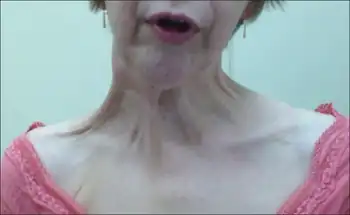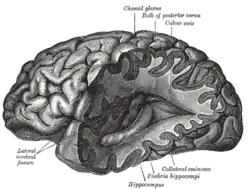Movement disorder
| Movement disorder | |
|---|---|
 | |
| Bilateral platysma dystonia (with involuntary jerk movement) | |
| Specialty | Neurology Psychiatry |
Movement disorder is a range of neurological motor disorders which may present with either slow movements or an excess of movements.[1]
Using the term movement disorders synonymously with basal ganglia or extrapyramidal diseases is generally an oversimplification; movement disorder encompasses a wider range of disorders.[1]
Classification
| Movement Disorders[2] | ICD-9-CM | ICD-10-CM |
|---|---|---|
| Hypokinetic Movement disorders | ||
| Parkinson's disease (Primary or Idiopathic Parkinsonism) | 332 | G20 |
| Secondary Parkinsonism | G21 | |
| Parkinson plus syndromes | ||
| Hallevorden-Spatz Disease | G23.0 | |
| Progressive Supranuclear Ophthalmoplegia | G23.1 | |
| Striatonigral degeneration | G23.2 | |
| Hyperkinetic Movement disorders | ||
| Dystonia | G24 | |
| Drug induced dystonia | G24.0 | |
| Idiopathic familial dystonia | 333.6 | G24.1 |
| Idiopathic nonfamilial dystonia | 333.7 | G24.2 |
| Spasmodic torticollis | 333.83 | G24.3 |
| Ideopathic orofacial dystonia | G24.4 | |
| Blepharospasm | 333.81 | G24.5 |
| Other dystonias | G24.8 | |
| Other extrapyramidal movement disorders | G25 | |
| Essential tremor | 333.1 | G25.0 |
| Drug induced tremor | G25.1 | |
| Other specified form of tremor | G25.2 | |
| Tremor unspecified | R25.1 | |
| Myoclonus | 333.2 | G25.3 |
| Opsoclonus | 379.59 | H57 |
| Chorea (rapid, involuntary movement) | ||
| Drug induced chorea | G25.4 | |
| Rheumatic chorea (Sydenham's chorea) | I02 | |
| Huntington's Chorea | 333.4 | G10 |
| Ballismus (violent involuntary rapid and irregular movements) | G25.85 | |
| Hemiballismus (affecting only one side of the body) | G25.85 | |
| Athetosis (contorted torsion or twisting) | 333.71 | R25.8 |
| Dyskinesia (abnormal, involuntary movement) | ||
| Tardive dyskinesia | ||
| Tic disorders (involuntary, compulsive, repetitive, stereotyped) | F95 | |
| Tourette's syndrome | F95.2 | |
| Drug-induced tics and tics of organic origin | 333.3 | G25.6 |
| Stereotypic movement disorder | F98.5 | |
| Paroxysmal nocturnal limb movement | G25.80 | |
| Painful legs (or arms), moving toes (or fingers) syndrome | G25.81 | |
| Sporadic restless leg syndrome | G25.82 | |
| Familial restless leg syndrome | G25.83 | |
| Stiff-person syndrome | 333.91 | G25.84 |
| Abnormal head movements | R25.0 | |
| Cramp and spasm | R25.2 | |
| Fasciculation | R25.3 |
Diagnosis
Step I : Decide the dominant type of movement disorder[3]
Step II : Make differential diagnosis of the particular disorder
Step II: Confirm the diagnosis by lab tests
- Metabolic screening
- Microbiology
- Immunology
- CSF examination
- Genetics
- Imaging
- Neurophysiological tests
- Pharmacological tests
Types
Movement disorders are conventionally divided into two major categories- hyperkinetic and hypokinetic.
Hyperkinetic movement disorders refer to dyskinesia, or excessive, often repetitive, involuntary movements that intrude upon the normal flow of motor activity.
Hypokinetic movement disorders refer to akinesia (lack of movement), hypokinesia (reduced amplitude of movements), bradykinesia (slow movement), and rigidity. In primary movement disorders, the abnormal movement is the primary manifestation of the disorder. In secondary movement disorders, the abnormal movement is a manifestation of another systemic or neurological disorder.[4]
Treatment
Treatment depends upon the underlying disorder.[5] Movement disorders have been known to be associated with a variety of autoimmune diseases.[6]
History
Vesalius and Piccolomini in 16th century distinguished subcortical nuclei from cortex and white matter. However Willis' conceptualized the corpus striatum as the seat of motor power in the late 17th century. In mid-19th-century movement disorders were localized to striatum by Choreaby Broadbent and Jackson, and athetosis by Hammond. By the late 19th century, many movement disorders were described but for most no pathologic correlate was known.[7]
References
- 1 2 Jankovic, Joseph; Lang, Anthony E. (2022). "24. Diagnosis and assessment of Parkinson Disease and other movement disorders". In Jankovic, Joseph; Mazziotta, John C.; Pomeroy, Scott L. (eds.). Bradley and Daroff's Neurology in Clinical Practice. Vol. I. Common neurological problems (8th ed.). Edinburgh: Elsevier. pp. 310–333. ISBN 978-0-323-64261-3. Archived from the original on 2023-07-01. Retrieved 2023-05-25.
- ↑ Singer, Harvey S.; Mink, Jonathan; Gilbert, Donald L.; Jankovic, Joseph (2015-10-27). Movement Disorders in Childhood. Academic Press. ISBN 9780124115804.
- ↑ Poewe, Werner; Jankovic, Joseph (2014-02-20). Movement Disorders in Neurologic and Systemic Disease. Cambridge University Press. ISBN 9781107024618. Archived from the original on 2019-12-16. Retrieved 2022-02-20.
- ↑ Flemming, Kelly; Jones, Lyell (2015-06-15). Mayo Clinic Neurology Board Review: Clinical Neurology for Initial Certification and MOC. Oxford University Press. ISBN 9780190244934. Archived from the original on 2019-12-16. Retrieved 2022-02-20.
- ↑ "MedlinePlus: Movement Disorders". Archived from the original on 2016-07-04. Retrieved 2022-02-20.
- ↑ Baizabal-Carvallo, JF; Jankovic J. (2012-07-18). "Movement disorders in autoimmune diseases". Movement Disorders. 27 (8): 935–46. doi:10.1002/mds.25011. PMID 22555904. S2CID 25191890.
- ↑ Lanska, Douglas J. (2010-01-01). "Chapter 33: the history of movement disorders". Handbook of Clinical Neurology. 95: 501–546. doi:10.1016/S0072-9752(08)02133-7. ISBN 9780444520098. ISSN 0072-9752. PMID 19892136.
External links
| Classification |
|---|
